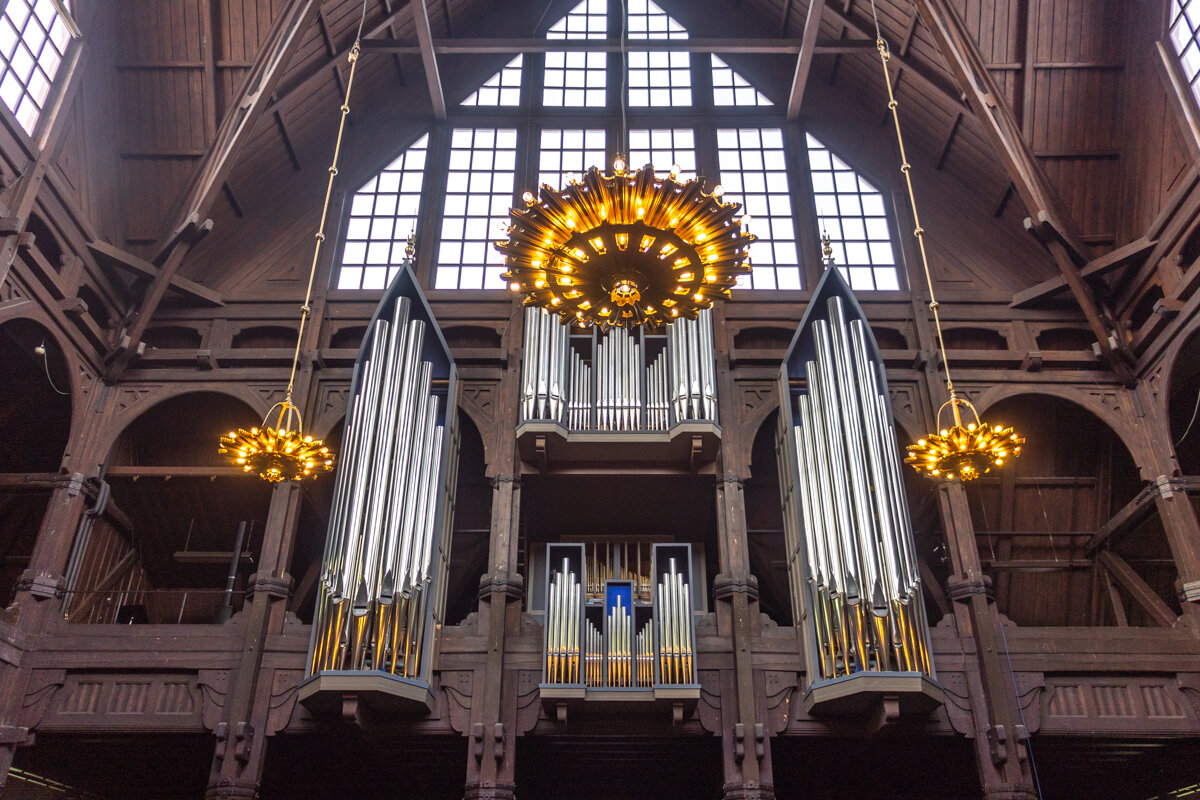Kiruna’s church, called Kiruna Kyrka by the locals, was built in the early 20th century by Gustaf Wickman. It is considered one of Sweden’s most beautiful churches, and one of the country’s largest wooden buildings. In addition to its atypical architecture, inspired by traditional Sami huts, it contains unique works by leading Swedish artists. It also has the distinction of having a bell tower on the outside, just a few meters from the main building.
Even if you’re not visiting Kiruna for its church, you won’t be disappointed by this remarkable building steeped in history.
Practical information about Kiruna church
To help you prepare for your visit, here’s all the information you need to know about Kiruna’s church.
Admission prices
Like most religious buildings, Kiruna’s church is free to enter. If you wish to make a donation, you can, of course, place a sum of your choice in a red urn at the entrance to the building.
You can also buy a postcard, for which you’ll have to spend a few Swedish kronor (SEK).

Opening hours
The Kiruna church is open daily, Monday to Sunday, from 10am to 3:30pm. However, if you come to visit the interior of the church, be careful not to disturb the religious practices of the locals, who may be gathered for some event.
Visit duration
Allow around 30 minutes in Kiruna’s church to admire the architecture and stroll around the surrounding area.


How do I get there?
Just a few minutes’ walk from Kiruna’s old town center, the church sits on a small hill to the west of the town.
If you’re coming by bus, the nearest stop is Kiruna Kyrkan, 550 meters to the north. Just cross the road to reach a driveway that leads straight to Kiruna Church.

If you’re travelling by car, free parking is also available right next door. This means you can park right next to the church building without any difficulty.
What to see in the church
Kiruna’s church is a religious building dating from the early 20th century, with two distinct sections. Its distinctive architecture features works by talented Swedish artists.

From the outside, Kiruna’s church stands out thanks to its red-painted wooden scales, known as“church shavings“. At the top of a hill, surrounded by a nature park populated by birch and mountain ash trees, you’ll appreciate the mix of architecture typical of Swedish churches and Sami huts.
In fact, once you’ve reached the top, you’ll be able to see an iron mine on the other side of the valley, west of Kiruna.



Once in front of the building’s main entrance, you’ll see a religious relief carved from wood, dominated by twelve bronze statues representing human emotions. These works were created by artist Christian Eriksson.
When you enter the Kiruna church, you can’t help but notice the painting at the back, behind the altar. This altarpiece, entitled“The Sacred Wood“, was painted by Prince Eugen of Sweden in 1912. You can also admire works by two other famous Swedish artists: Albert Engström and Ossian Elgström. You may also hear the church organ , located just above the entrance.


Finally, when you leave the church, don’t forget to take a look at the bell tower, located just outside the main building. In fact, the tomb of Hjalmar Lundbohm, the first director of LKAB and one of the founders of the city of Kiruna, is located underneath.
History of the Kiruna church
Gustaf Wickman (1858-1916) was a Swedish architect . He arrived in Kiruna in 1899 and built many public buildings, including the church between 1909 and 1912. It was commissioned by Hjalmar Lundbom (1855-1926), the first director of the LKAB iron ore mine and founder of the town of Kiruna.
Lundbom played a major role in the development of the mining town. Buried in Stockholm, he was later moved to Kiruna, where he is buried under the church steeple. His grave can still be visited today.


Christian Eriksson (1858-1935) is a Swedish sculptor . He created the twelve Vertus sculptures on the eaves of Kiruna church, as well as the relief above the church portal. He was also involved in the creation of the statue of Hjalmar Lundbohm, built in 1924.
The church will be completely dismantled and reassembled in the new town center by 2035, in view of the relocation of the town due to subsidence caused by mining activity.
Even if you don’t come to Kiruna especially for its church, it’s still an exceptional place to visit and enjoy its architecture, artworks and distinctive woodsy fragrance in between outdoor activities.